Impacts of Precipitation and Temperature on Changes in the Terrestrial Ecosystem Pattern in the Yangtze River Economic Belt, China
Abstract
:1. Introduction
2. Materials and Methods
2.1. Study Area
2.2. Research Framework
2.3. Methods
2.3.1. Spatial Transfer Matrix
2.3.2. Terrestrial Ecosystem Pattern Dynamic Degree
2.3.3. Bivariate Spatial Autocorrelation
2.3.4. Panel Regression Model
2.4. Data Source and Processing
3. Results
3.1. Spatial-Temporal Evolution of Precipitation and Temperature
3.1.1. Spatial-Temporal Evolution of Precipitation
3.1.2. Spatial-Temporal Evolution of Temperature
3.2. Spatial-Temporal Evolution of the Terrestrial Ecosystem Pattern
3.2.1. Spatial Variation Characteristics
3.2.2. Temporal Evolution Characteristics
3.3. Spatial Correlation Between Precipitation and the Terrestrial Ecosystem
3.3.1. Bivariate Autocorrelation Characteristics of Global Space
3.3.2. Bivariate Autocorrelation Characteristics of Local Space
3.4. Impacts of Precipitation and Temperature on Terrestrial Ecosystem Pattern Change
3.4.1. Impact Utility on the Provincial Scale
3.4.2. Impact Utility on the City Scale
3.4.3. Analysis of Policy Impact
4. Discussion
4.1. Comparison with Previous Studies
4.2. Applications and Suggestions
4.3. Limitations
5. Conclusions
Author Contributions
Funding
Conflicts of Interest
References
- Yu, D.Y.; Liu, Y.P.; Shi, P.J.; Wu, J.G. Projecting impacts of climate change on global terrestrial ecoregions. Ecol. Indic. 2019, 103, 114–123. [Google Scholar] [CrossRef]
- Sun, Q.Q.; Meyer, W.S.; Marschner, P. Direct and carry-over effects of summer rainfall on ecosystem carbon uptake and water use efficiency in a semi-arid woodland. Agric. For. Meteorol. 2018, 263, 15–24. [Google Scholar] [CrossRef]
- Zhang, Z.Y.; Zhang, R.D.; Zhou, Y.; Cescatti, A.; Wohlfahrt, G.; Sun, M.M.; Zhang, H.Y.; Qi, J.X.; Zhu, J.; Magliulo, V.; et al. A temperature threshold to identify the driving climate forces of the respiratory process in terrestrial ecosystems. Eur. J. Soil Biol. 2018, 89, 1–8. [Google Scholar] [CrossRef]
- Nelson, E.; Bhagabati, N.; Ennaanay, D.; Lonsdorf, E.; Pennington, D.; Sharma, M. Modeling Terrestrial Ecosystem Services. In Encyclopedia of Biodiversity, 2nd ed.; Levin, S.A., Ed.; Academic Press: Waltham MA, USA, 2013; pp. 347–361. [Google Scholar]
- Coskun, D.; Britto, D.T.; Kronzucker, H.J. Nutrient constraints on terrestrial carbon fixation: The role of nitrogen. J. Plant Physiol. 2016, 203, 95–109. [Google Scholar] [CrossRef] [PubMed]
- Xiao, J.F.; Sun, G.; Chen, J.Q.; Chen, H.; Chen, S.P.; Dong, G.; Gao, S.H.; Guo, H.Q.; Guo, J.X.; Han, S.J.; et al. Carbon fluxes, evapotranspiration, and water use efficiency of terrestrial ecosystems in China. Agric. For. Meteorol. 2013, 182–183, 76–90. [Google Scholar] [CrossRef]
- Song, Z.L.; McGrouther, K.; Wang, H.L. Occurrence, turnover and carbon sequestration potential of phytoliths in terrestrial ecosystems. Earth Sci. Rev. 2016, 158, 19–30. [Google Scholar] [CrossRef]
- Wu, B.; Amelung, W.; Xing, Y.; Bol, R.; Berns, A.E. Iron cycling and isotope fractionation in terrestrial ecosystems. Earth Sci. Rev. 2019, 190, 323–352. [Google Scholar] [CrossRef]
- Bokhorst, S.; Convey, P.; Aerts, R. Nitrogen inputs by Marine vertebrates drive abundance and richness in Antarctic terrestrial ecosystems. Curr. Biol. 2019, 29, 1721–1727. [Google Scholar] [CrossRef]
- Lu, X.H.; Ju, W.M.; Jiang, H.; Zhang, X.Y.; Liu, J.X.; Sherba, J.; Wang, S.H. Effects of nitrogen deposition on water use efficiency of global terrestrial ecosystems simulated using the IBIS model. Ecol. Indic. 2019, 101, 954–962. [Google Scholar] [CrossRef]
- Xu, H.J.; Zhao, C.Y.; Wang, X.P. Spatiotemporal differentiation of the terrestrial gross primary production response to climate constraints in a dryland mountain ecosystem of northwestern China. Agric. For. Meteorol. 2019, 276–277, 107628. [Google Scholar] [CrossRef]
- Smith, A.M.S.; Kolden, C.A.; Tinkham, W.T.; Talhelm, A.F.; Marshall, J.D.; Hudak, A.T.; Boschetti, L.; Falkowski, M.J.; Greenberg, J.A.; Anderson, J.W.; et al. Remote sensing the vulnerability of vegetation in natural terrestrial ecosystems. Remote Sens. Environ. 2014, 154, 322–337. [Google Scholar] [CrossRef]
- Wang, X.Y.; Wu, C.Y. Estimating the peak of growing season (POS) of China’s terrestrial ecosystems. Agric. For. Meteorol. 2019, 278, 107639. [Google Scholar] [CrossRef]
- Blumetto, O.; Castagna, A.; Cardozo, G.; García, F.; Tiscornia, G.; Ruggia, A.; Scarlato, S.; Albicette, M.M.; Aguerre, V.; Albin, A. Ecosystem Integrity Index, an innovative environmental evaluation tool for agricultural production systems. Ecol. Indic. 2019, 101, 725–733. [Google Scholar] [CrossRef]
- Dou, X.M.; Yang, Y.G. Evapotranspiration estimation using four different machine learning approaches in different terrestrial ecosystems. Comput. Electron. Agric. 2018, 148, 95–106. [Google Scholar] [CrossRef]
- Mendoza-Ponce, A.; Corona-Núñez, R.; Kraxner, F.; Leduc, S.; Patrizio, P. Identifying effects of land use cover changes and climate change on terrestrial ecosystems and carbon stocks in Mexico. Glob. Environ. Chang. 2018, 53, 12–23. [Google Scholar] [CrossRef] [Green Version]
- Fei, X.H.; Song, Q.H.; Zhang, Y.P.; Liu, Y.T.; Sha, L.Q.; Yu, G.R.; Zhang, L.M.; Duan, C.Q.; Deng, Y.; Wu, C.S.; et al. Carbon exchanges and their responses to temperature and precipitation in forest ecosystems in Yunnan, Southwest China. Sci. Total Environ. 2018, 616–617, 824–840. [Google Scholar] [CrossRef]
- Krauze, K.; Wagner, I. From classical water-ecosystem theories to nature-based solutions—Contextualizing nature-based solutions for sustainable city. Sci. Total Environ. 2019, 655, 697–706. [Google Scholar] [CrossRef]
- Häder, D.-P.; Barnes, P.W. Comparing the impacts of climate change on the responses and linkages between terrestrial and water ecosystems. Sci. Total Environ. 2019, 682, 239–246. [Google Scholar] [CrossRef]
- Wen, Y.Y.; Liu, X.P.; Bai, Y.; Sun, Y.; Yang, J.; Lin, K.; Pei, F.S.; Yan, Y.C. Determining the impacts of climate change and urban expansion on terrestrial net primary production in China. J. Environ. Manag. 2019, 240, 75–83. [Google Scholar] [CrossRef]
- Sun, Z.Y.; Wang, X.F.; Yamamoto, H.; Tani, H.; Zhong, G.S.; Yin, S.; Guo, E.L. Spatial pattern of GPP variations in terrestrial ecosystems and its drivers: Climatic factors, CO2 concentration and land-cover change, 1982–2015. Ecol. Inform. 2018, 46, 156–165. [Google Scholar] [CrossRef]
- Huang, C.; Zhou, Z.X.; Peng, C.H.; Teng, M.J.; Wang, P.C. How is biodiversity changing in response to ecological restoration in terrestrial ecosystems? A meta-analysis in China. Sci. Total Environ. 2019, 650, 1–9. [Google Scholar] [CrossRef] [PubMed]
- Chen, D.D.; Deng, X.Z.; Jin, G.; Samie, A.; Li, Z.H. Land-use-change induced dynamics of carbon stocks of the terrestrial ecosystem in Pakistan. Phys. Chem. Earth Parts A/B/C 2017, 101, 13–20. [Google Scholar] [CrossRef]
- Guillén, J.; Beresford, N.A.; Baeza, A.; Izquierdo, M.; Wood, M.D.; Salas, A.; Muñoz-Serrano, A.; Corrales-Vázquez, J.M.; Muñoz-Muñoz, J.G. Transfer parameters for ICRP’s reference animals and plants in a terrestrial mediterranean ecosystem. J. Environ. Radioact. 2018, 186, 9–22. [Google Scholar] [CrossRef] [PubMed]
- He, B.; Cui, X.F.; Wang, H.L.; Chen, A.F. Drought: The most important physical stress of terrestrial ecosystems. Acta Ecol. Sin. 2014, 34, 179–183. [Google Scholar] [CrossRef]
- Hao, R.F.; Yu, D.Y.; Sun, Y.; Shi, M.C. The features and influential factors of interactions among ecosystem services. Ecol. Indic. 2019, 101, 770–779. [Google Scholar] [CrossRef]
- Wang, Y.; Sun, J.; Liu, M.; Zeng, T.; Tsunekawa, A.; Mubarak, A.A.; Zhou, H.K. Precipitation-use efficiency may explain net primary productivity allocation under different precipitation conditions across global grassland ecosystems. Glob. Ecol. Conserv. 2019, 20, e00713. [Google Scholar] [CrossRef]
- Zhao, J.X.; Luo, T.X.; Li, R.C.; Wei, H.X.; Li, X.; Du, M.Y.; Tang, Y.H. Precipitation alters temperature effects on ecosystem respiration in Tibetan alpine meadows. Agric. For. Meteorol. 2018, 252, 121–129. [Google Scholar] [CrossRef]
- Huang, Y.; Li, L.; Yu, Y.T. Do urban agglomerations outperform non-agglomerations? A new perspective on exploring the eco-efficiency of Yangtze River Economic Belt in China. J. Clean. Prod. 2018, 202, 1056–1067. [Google Scholar] [CrossRef]
- Xu, X.B.; Yang, G.S.; Tan, Y. Identifying ecological red lines in China’s Yangtze River Economic Belt: A regional approach. Ecol. Indic. 2019, 96, 635–646. [Google Scholar] [CrossRef]
- Xu, X.B.; Yang, G.S.; Tan, Y.; Liu, J.P.; Hu, H.Z. Ecosystem services trade-offs and determinants in China’s Yangtze River Economic Belt from 2000 to 2015. Sci. Total Environ. 2018, 634, 1601–1614. [Google Scholar] [CrossRef]
- Chen, Y.S.; Zhang, S.H.; Huang, D.S.; Li, B.L.; Liu, J.G.; Liu, W.J.; Ma, J.; Wang, F.; Wang, Y.; Wu, S.J.; et al. The development of China’s Yangtze River Economic Belt: How to make it in a green way? Sci. Bull. 2017, 62, 648–651. [Google Scholar] [CrossRef] [Green Version]
- Luo, Q.L.; Luo, Y.L.; Zhou, Q.F.; Song, Y. Does China’s Yangtze River Economic Belt policy impact on local ecosystem services? Sci. Total Environ. 2019, 676, 231–241. [Google Scholar] [CrossRef] [PubMed]
- Chen, J.X.; Zhang, Y.G.; Zheng, S.L. Ecoefficiency, environmental regulation opportunity costs, and interregional industrial transfers: Evidence from the Yangtze River Economic Belt in China. J. Clean. Prod. 2019, 233, 611–625. [Google Scholar] [CrossRef]
- Liu, G.; Wang, W.Q.; Li, W.K. Water footprint allocation under equity and efficiency considerations: A case study of the Yangtze River Economic Belt in China. Int. J. Environ. Res. Public Health 2019, 16, 743. [Google Scholar] [CrossRef] [PubMed] [Green Version]
- Tian, Z.; Ren, F.R.; Xiao, Q.W.; Chiu, Y.H.; Lin, T.Y. Cross-regional comparative study on carbon emission efficiency of China’s Yangtze River Economic Belt based on the meta-frontier. Int. J. Environ. Res. Public Health 2019, 16, 619. [Google Scholar] [CrossRef] [PubMed] [Green Version]
- Jin, G.; Deng, X.Z.; Zhao, X.D.; Guo, B.S.; Yang, J. Spatiotemporal patterns in urbanization efficiency within the Yangtze River Economic Belt between 2005 and 2014. J. Geogr. Sci. 2018, 28, 1113–1126. [Google Scholar] [CrossRef] [Green Version]
- Ministry of Ecology and Environmental of the People’s Republic of China; National Development and Reform Commission of the People’s Republic of China; Ministry of Water Resources of the People’s Republic of China. Ecological Environment Protection Planning of the Yangtze River Economic Belt. Available online: http://www.mee.gov.cn/gkml/hbb/bwj/201707/t20170718_418053_wap.shtml (accessed on 7 June 2019).
- Resource and Environment Science Data Center of the Chinese Academy of Sciences. Available online: http://www.resdc.cn/ (accessed on 12 May 2019).
- Wu, L.N.; Yang, S.T.; Liu, X.Y.; Luo, Y.; Zhou, X.; Zhao, H.G. Response analysis of land use change to the degree of human activities in Beiluo River basin since 1976. Acta Geogr. Sin. 2014, 69, 54–63. (In Chinese) [Google Scholar]
- Li, S.C.; Bing, Z.L.; Jin, G. Spatially explicit mapping of soil conservation service in monetary units due to land use/cover change for the Three Gorges reservoir area, China. Remote Sens. 2019, 11, 468. [Google Scholar] [CrossRef] [Green Version]
- Jin, G.; Chen, K.; Wang, P.; Guo, B.S.; Dong, Y.; Yang, J. Trade-offs in land-use competition and sustainable land development in the North China Plain. Technol. Forecast. Soc. Chang. 2019, 141, 36–46. [Google Scholar] [CrossRef]
- Moody, H.; Grady, C.S. Lead emissions and population vulnerability in the Detroit (Michigan, USA) Metropolitan area, 2006–2013: A spatial and temporal analysis. Int. J. Environ. Res. Public Health 2017, 14, 1445. [Google Scholar] [CrossRef] [Green Version]
- Jin, G.; Li, Z.H.; Deng, X.Z.; Yang, J.; Chen, D.D.; Li, W.Q. An analysis of spatiotemporal patterns in Chinese agricultural productivity between 2004 and 2014. Ecol. Indic. 2019, 105, 591–600. [Google Scholar] [CrossRef]
- Xing, Z.C.; Wang, J.G.; Zhang, J. Total-factor ecological efficiency and productivity in Yangtze River Economic Belt, China: A non-parametric distance function approach. J. Clean. Prod. 2018, 200, 844–857. [Google Scholar] [CrossRef]
- Liu, Y.L.; Zhang, X.H.; Kong, X.S.; Wang, R.; Chen, L. Identifying the relationship between urban land expansion and human activities in the Yangtze River Economic Belt, China. Appl. Geogr. 2018, 94, 163–177. [Google Scholar] [CrossRef]


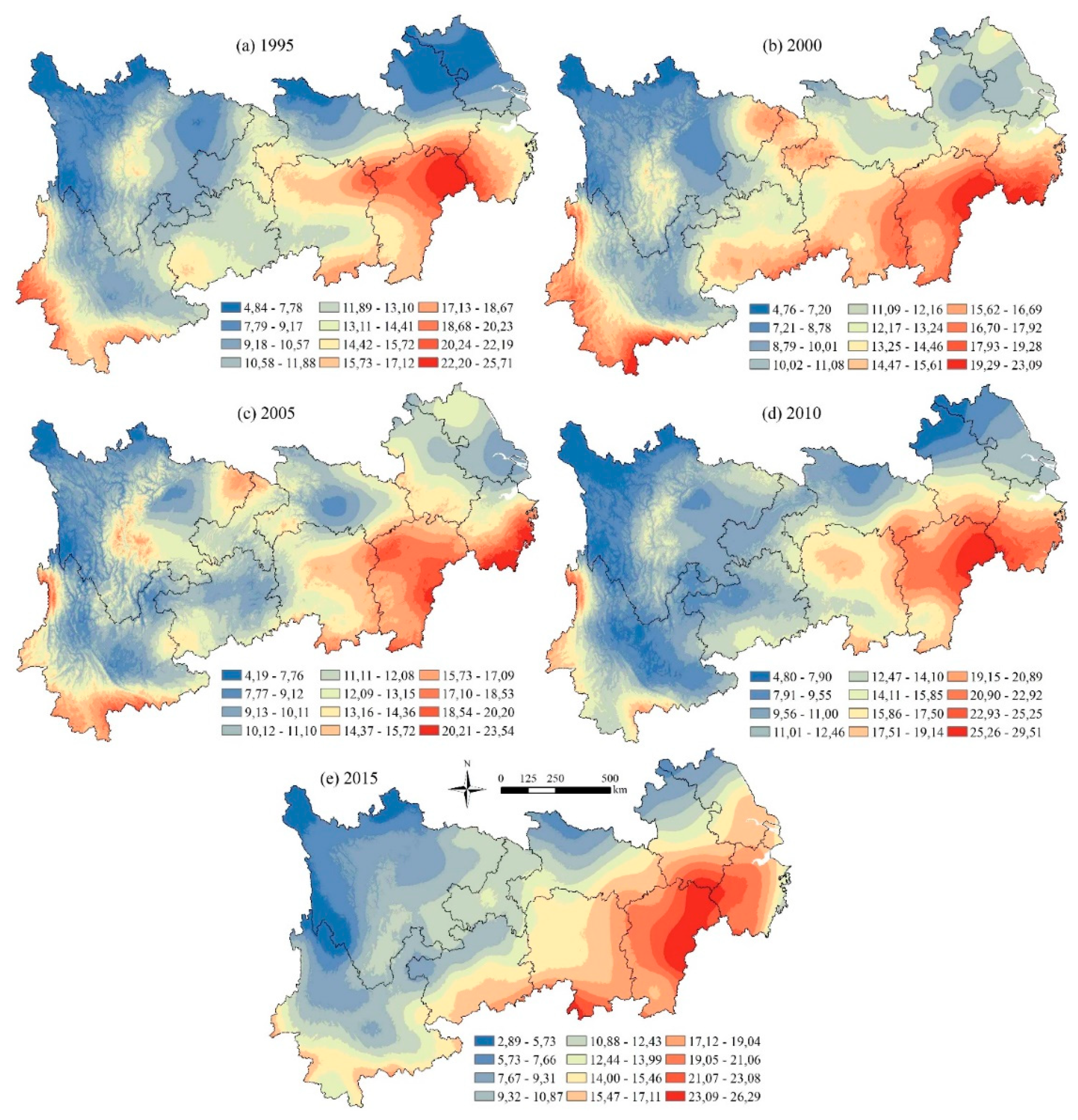
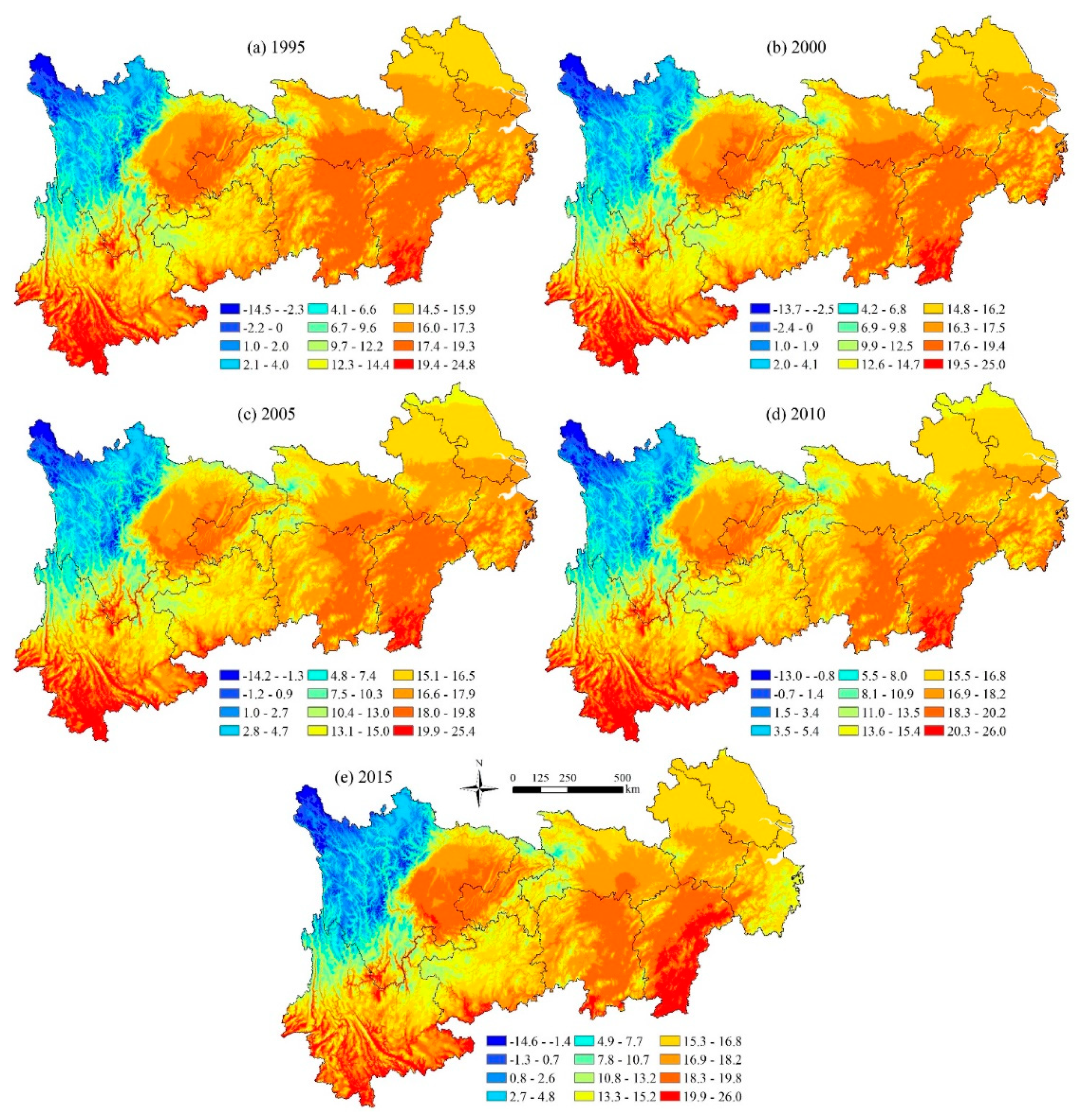
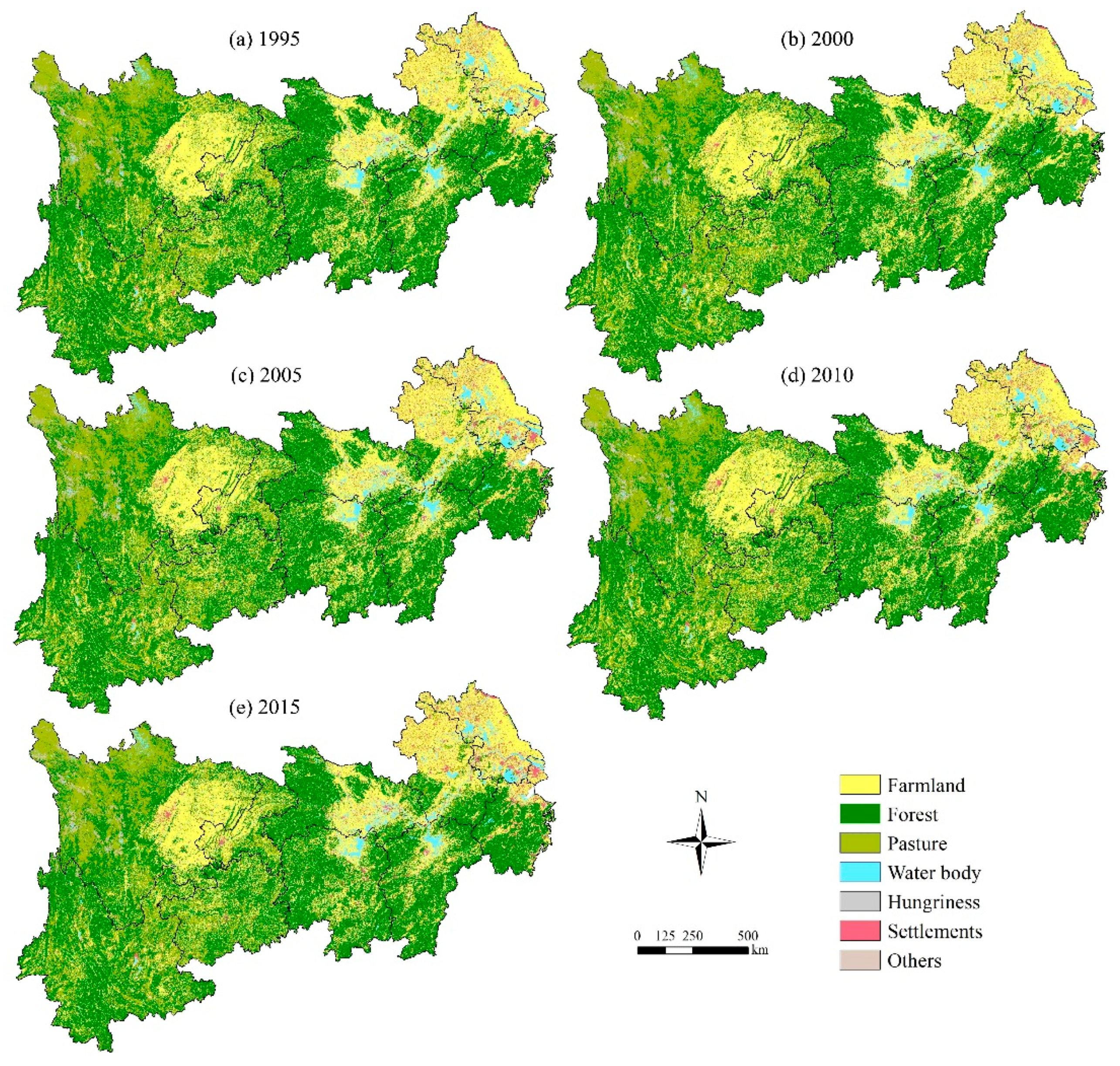
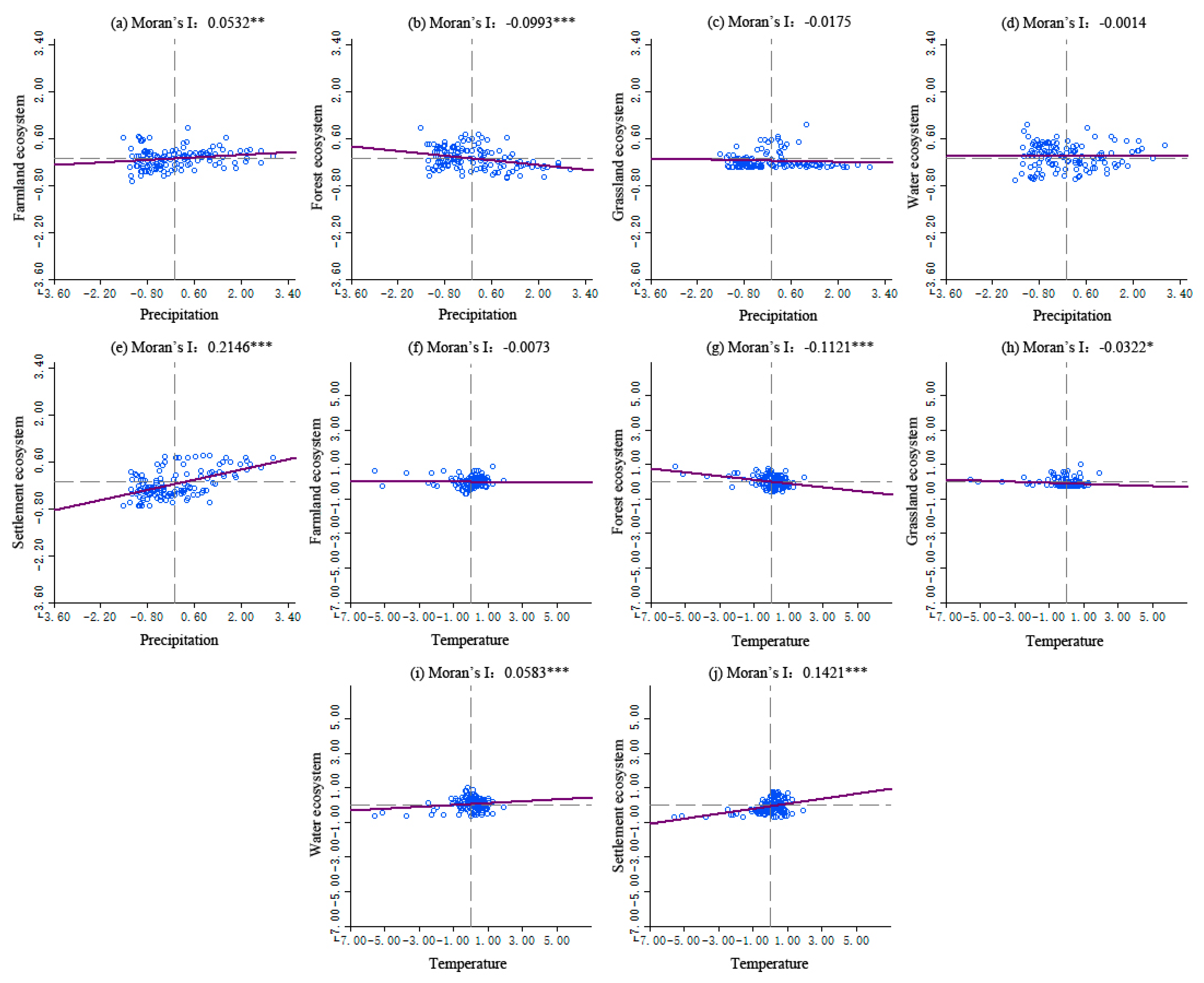
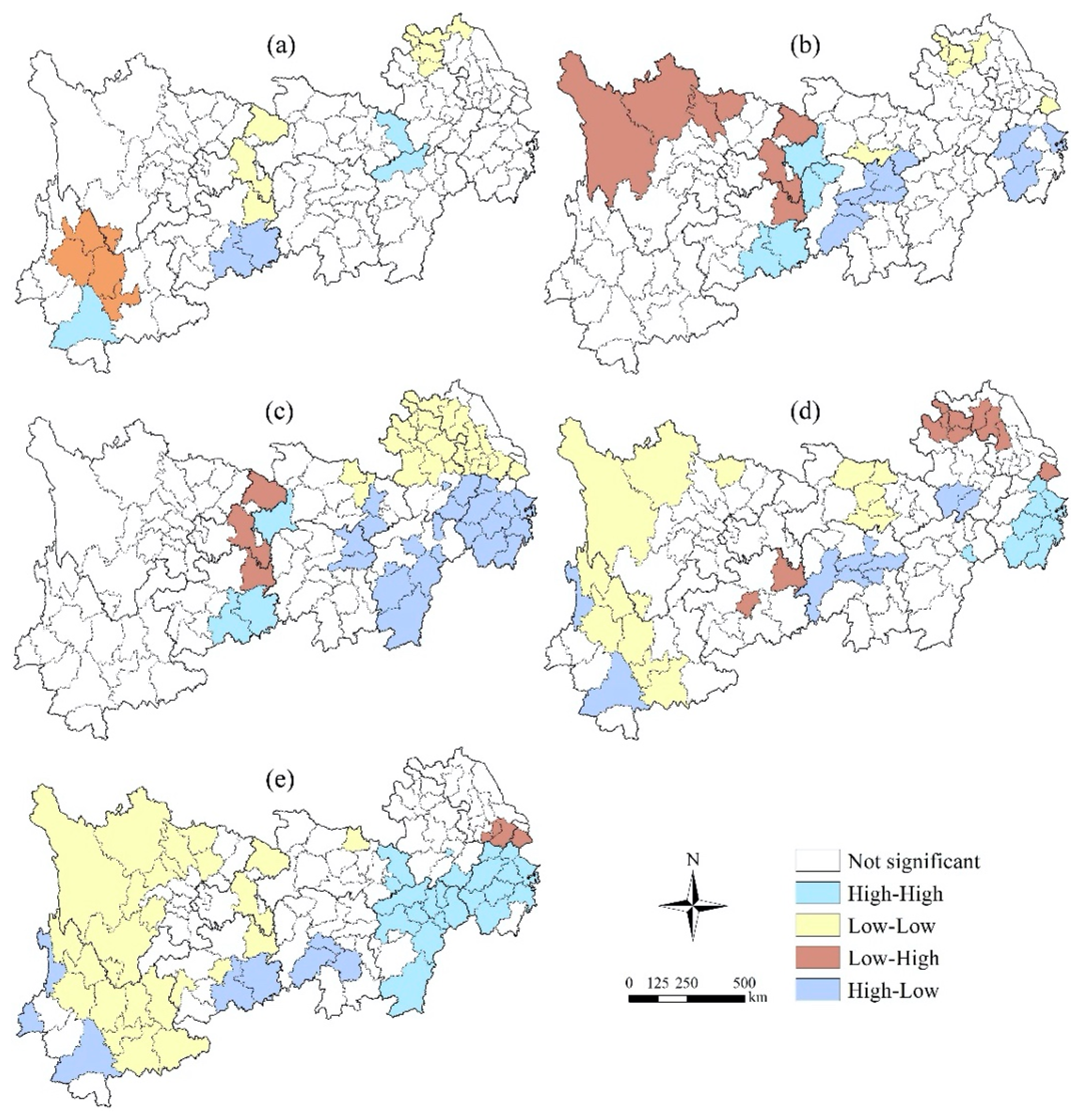
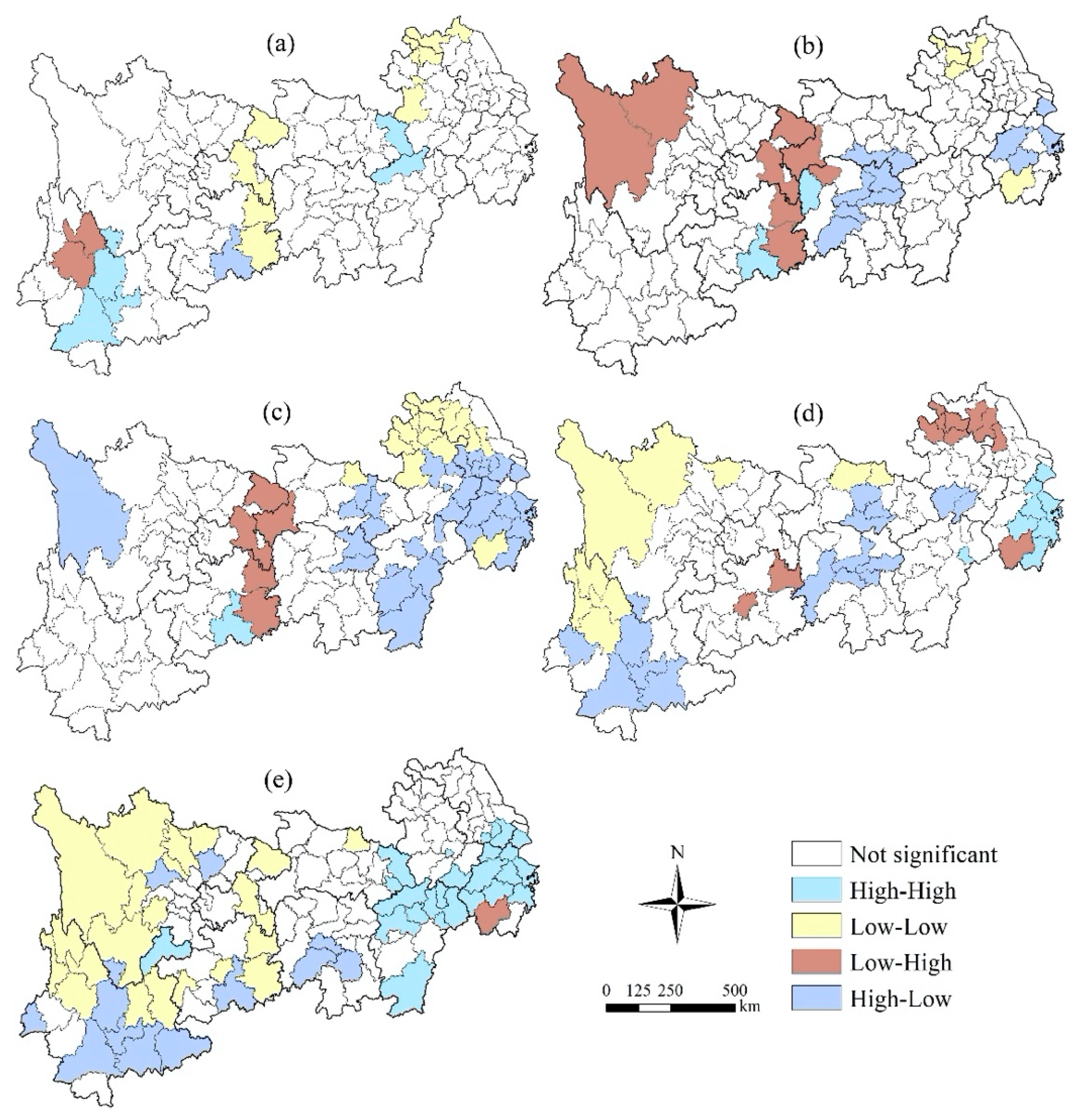


| Region of YREB | Province/City | 1995 | 2000 | 2005 | 2010 | 2015 | Trend Line | Average |
|---|---|---|---|---|---|---|---|---|
| Head region | Yunnan, Guizhou, Sichuan, Chongqing | 1205 | 1233 | 1149 | 1133 | 1119 |  |  |
| Central region | Hubei, Hunan, Jiangxi | 1524 | 1496 | 1422 | 1695 | 1648 |  |  |
| Tail region | Anhui, Shanghai, Jiangsu, Zhejiang | 1177 | 1279 | 1237 | 1392 | 1542 |  |  |
| Whole regions | All eleven provinces | 1302 | 1336 | 1269 | 1407 | 1437 |  |  |
| Region of YREB | Province/City | 1995 | 2000 | 2005 | 2010 | 2015 | Trend Line | Average |
|---|---|---|---|---|---|---|---|---|
| Head region | Yunnan, Guizhou, Sichuan, Chongqing | 13.8 | 13.8 | 14.3 | 14.7 | 14.3 |  |  |
| Central region | Hubei, Hunan, Jiangxi | 16.9 | 16.9 | 17.2 | 17.4 | 17.5 |  |  |
| Tail region | Anhui, Shanghai, Jiangsu, Zhejiang | 16.0 | 16.6 | 16.5 | 16.6 | 16.0 |  |  |
| Whole regions | All eleven provinces | 15.6 | 15.8 | 16.0 | 16.2 | 16.0 |  |  |
| Later Year | Terrestrial Ecosystem | Farmland | Forest | Grassland | Water | Settlement | Total |
|---|---|---|---|---|---|---|---|
| Early Year | |||||||
| 1995–2000 | Farmland | 1266.0 | 205.8 | 151.3 | 34.4 | 88.1 | 479.6 |
| Forest | 234.3 | 1774.6 | 220.5 | 18.7 | 8.3 | 481.8 | |
| Grassland | 167.8 | 221.3 | 2298.5 | 43.8 | 6.9 | 439.8 | |
| Water | 34.2 | 15.6 | 43.8 | 225.3 | 4.0 | 97.6 | |
| Settlement | 85.6 | 7.1 | 6.7 | 4.2 | 63.3 | 103.6 | |
| Total | 522.0 | 449.7 | 422.3 | 101.1 | 107.3 | - | |
| 2001–2005 | Farmland | 1775.9 | 4.0 | 5.0 | 3.3 | 11.7 | 24.1 |
| Forest | 2.3 | 2235.5 | 2.3 | 0.7 | 1.9 | 7.1 | |
| Grassland | 9.3 | 5.7 | 2989.2 | 1.4 | 1.0 | 17.4 | |
| Water | 2.6 | 0.3 | 1.3 | 350.0 | 1.1 | 5.2 | |
| Settlement | 0.2 | 0.1 | 0.1 | 0.1 | 172.0 | 0.4 | |
| Total | 14.4 | 10.1 | 8.8 | 5.5 | 15.6 | - | |
| 2006–2010 | Farmland | 1781.9 | 1.8 | 1.3 | 1.1 | 7.1 | 11.3 |
| Forest | 1.0 | 2242.1 | 1.3 | 0.3 | 1.0 | 3.6 | |
| Grassland | 2.5 | 2.1 | 2994.1 | 0.7 | 0.5 | 5.8 | |
| Water | 0.9 | 0.1 | 0.6 | 354.8 | 0.5 | 2.1 | |
| Settlement | 0.1 | 0.0 | 0.0 | 0.1 | 188.1 | 0.3 | |
| Total | 4.6 | 4.0 | 3.2 | 2.1 | 9.2 | - | |
| 2011–2015 | Farmland | 1768.5 | 1.1 | 1.5 | 1.6 | 14.9 | 19.0 |
| Forest | 2.4 | 2237.3 | 2.1 | 0.6 | 3.6 | 8.8 | |
| Grassland | 7.8 | 1.0 | 2983.5 | 2.0 | 3.9 | 14.7 | |
| Water | 2.0 | 0.1 | 0.9 | 352.9 | 1.1 | 4.2 | |
| Settlement | 1.2 | 0.3 | 0.2 | 0.2 | 196.0 | 1.8 | |
| Total | 13.5 | 2.4 | 4.6 | 4.4 | 23.5 | - | |
| 1995–2015 | Farmland | 1237.6 | 206.9 | 149.8 | 36.5 | 115.3 | 508.5 |
| Forest | 232.8 | 1767.4 | 221.5 | 19.8 | 14.8 | 488.9 | |
| Grassland | 178.4 | 224.9 | 2277.4 | 45.4 | 12.1 | 460.8 | |
| Water | 35.9 | 15.4 | 44.0 | 220.8 | 6.5 | 101.8 | |
| Settlement | 81.8 | 6.8 | 6.6 | 4.2 | 67.7 | 85.2 | |
| Total | 528.9 | 453.9 | 421.9 | 105.8 | 148.7 | - |
| Ecosystem | 1995–2000 | 2000–2005 | 2005–2010 | 2010–2015 | 1995–2015 | |||||
|---|---|---|---|---|---|---|---|---|---|---|
| AREA (km2) | TEDD (%) | AREA (km2) | TEDD (%) | AREA (km2) | TEDD (%) | AREA (km2) | TEDD (%) | AREA (km2) | TEDD (%) | |
| Farmland ecosystem | 5769 | 0.91 | −6522 | −1.02 | −4953 | −0.78 | −7980 | −1.27 | −13,686 | −0.02 |
| Forest ecosystem | −12,351 | −1.30 | 1128 | 0.12 | 414 | 0.04 | −2780 | −0.30 | −13,589 | −0.01 |
| Grassland ecosystem | 3088 | 0.91 | −1414 | −0.41 | −504 | −0.15 | −314 | −0.09 | 856 | 0.00 |
| Water ecosystem | 1784 | 2.93 | 1257 | 2.01 | 478 | 0.75 | 955 | 1.48 | 4474 | 0.07 |
| Settlement ecosystem | 2211 | 4.93 | 5645 | 12.00 | 4520 | 8.58 | 10,243 | 17.90 | 22,619 | 0.50 |
| Region of YREB | Province/City | x1 | x2 | x3 | x4 | x5 | y1 | y2 | y3 | y4 | y5 |
|---|---|---|---|---|---|---|---|---|---|---|---|
| Head region | Sichuan | 0.017 | 0.127 | 0.110 | −0.224 | 0.004 | −0.364 | −0.280 | −0.958 | 0.140 | 0.334 |
| Yunnan | −0.052 | 0.408 | 0.028 | −0.386 | 0.007 | −0.507 | −0.571 | −1.660 | −0.252 | −1.757 | |
| Chongqing | 0.036 | 1.299 | −0.137 | −3.804 | 0.221 | −7.755 | −0.457 | 0.375 | −0.816 | 8.400 | |
| Guizhou | −0.114 | 0.347 | 0.045 | −0.281 | 0.239 | −1.363 | 0.300 | 0.965 | −0.202 | −0.756 | |
| Central region | Hubei | 0.015 | −0.792 | −0.005 | −0.746 | 0.632 | −5.128 | −0.070 | 1.131 | −0.211 | −5.306 |
| Hunan | −0.016 | 0.391 | −0.004 | −0.829 | 0.125 | −1.918 | −0.124 | −0.954 | −0.146 | −1.649 | |
| Jiangxi | −0.024 | 0.006 | −0.058 | −0.410 | 0.640 | −4.689 | 0.022 | −0.996 | 0.321 | −3.069 | |
| Tail region | Anhui | −0.041 | −0.772 | −0.042 | −0.015 | 0.114 | −0.954 | −0.152 | −2.786 | −0.114 | −5.613 |
| Jiangsu | −0.134 | −0.629 | −0.052 | −0.111 | −0.051 | −0.515 | −0.051 | −1.587 | −0.076 | −2.456 | |
| Shanghai | −0.252 | −0.530 | −0.114 | 0.074 | −0.030 | −6.407 | −0.231 | −0.167 | −0.388 | 1.258 | |
| Zhejiang | −0.264 | −0.431 | −0.138 | −0.010 | 0.180 | −5.300 | 0.152 | 0.259 | 1.056 | 2.107 |
© 2019 by the authors. Licensee MDPI, Basel, Switzerland. This article is an open access article distributed under the terms and conditions of the Creative Commons Attribution (CC BY) license (http://creativecommons.org/licenses/by/4.0/).
Share and Cite
Xiang, J.; Zhang, W.; Song, X.; Li, J. Impacts of Precipitation and Temperature on Changes in the Terrestrial Ecosystem Pattern in the Yangtze River Economic Belt, China. Int. J. Environ. Res. Public Health 2019, 16, 4872. https://0-doi-org.brum.beds.ac.uk/10.3390/ijerph16234872
Xiang J, Zhang W, Song X, Li J. Impacts of Precipitation and Temperature on Changes in the Terrestrial Ecosystem Pattern in the Yangtze River Economic Belt, China. International Journal of Environmental Research and Public Health. 2019; 16(23):4872. https://0-doi-org.brum.beds.ac.uk/10.3390/ijerph16234872
Chicago/Turabian StyleXiang, Jingwei, Weina Zhang, Xiaoqing Song, and Jiangfeng Li. 2019. "Impacts of Precipitation and Temperature on Changes in the Terrestrial Ecosystem Pattern in the Yangtze River Economic Belt, China" International Journal of Environmental Research and Public Health 16, no. 23: 4872. https://0-doi-org.brum.beds.ac.uk/10.3390/ijerph16234872




